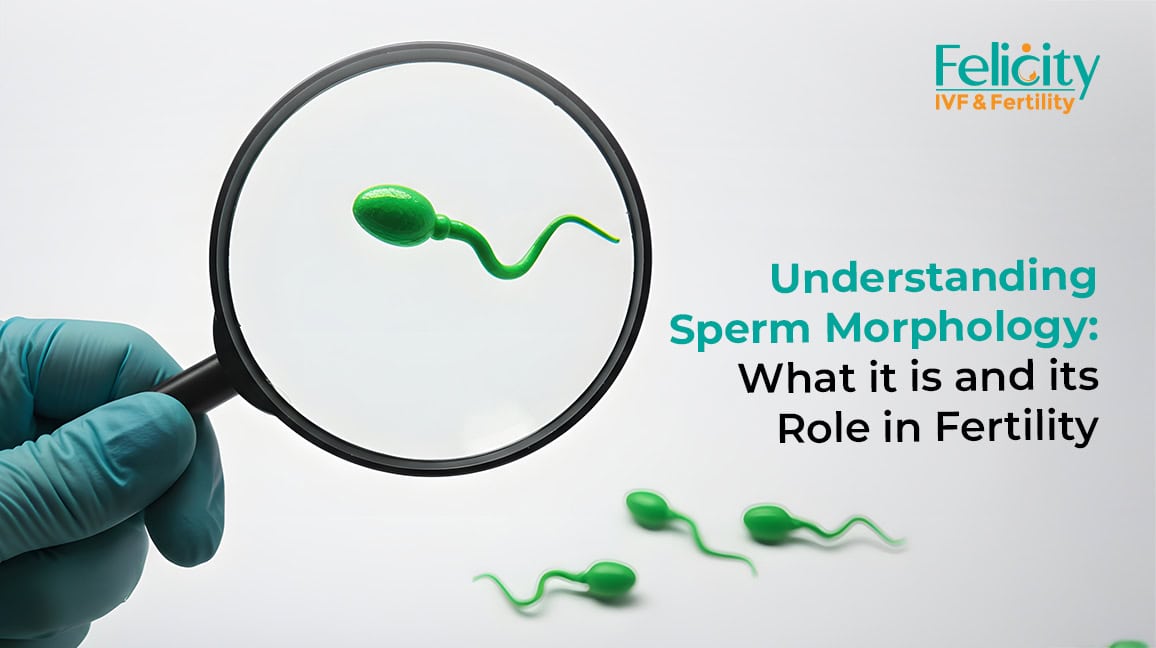Understanding Sperm Morphology: What It Is and Its Role in Fertility

Sperm morphology is an important factor in male fertility, but is generally ignored. It is the size and shape of the sperm cells of men which may determine the ability to conceive. As important as their morphology is in understanding fertility among couples who wish to bear children, or any other person who wants to improve reproductive health, it is worth examining the morphology, what is normal sperm morphology, and how abnormal sperm morphology occurs so that it will shed more light on this vital factor in fertility. The sperm morphology is actually what it purports to be: the shape of the sperm cell’s head, midpiece, and tail of sperm cells. All these structures must be well-formed and functional for the sperm to swim towards and fertilise the egg.
Normal Sperm Morphology:
Normal morphology means that the sperm cells have the right shape and structure needed for fertilisation. This contains:
- Head: Oval or elliptical, smooth, not too big, nor too small. Midpiece: Well-defined and compact with a healthy number of mitochondria that give energy to the sperm.
- Tail: Long and flexible to allow the sperm to swim towards the egg.
Why Is Sperm Morphology So Important for Fertility?
There is a big role of sperm morphology in conception. The shape of sperm contributes to its motility (movement) toward the egg. Even if sperm counts and motility are normal, the morphology could still decrease the likelihood of successful fertilisation.
A sperm analysis evaluating their morphology can help rule out abnormal morphology as a contributor to infertility. Poor morphology may keep the sperm from being able to swim effectively into the egg’s protective layer and make it difficult to achieve conception.
What Are the Causes of Abnormal Sperm Morphology?
There are usually several causes of abnormal sperm morphology, for which it becomes necessary to study and understand the causes listed above; it makes dealing with infertility easier. Some of the common reasons include:
- Genetic Factors: Genetic abnormalities as mutations passed on to some men lead to disturbances in sperm production and morphology.
- Environmental Factors: Various environmental chemicals, toxins, and heavy metals can disrupt sperm development and shape.
- Lifestyle Choices: Smoking, heavy use of alcohol, poor diet, and lack of exercise can contribute to abnormal morphology.
- Medical Conditions: Health conditions such as varicocele (swelling of veins in the scrotum), diabetes, and infections may also bring problems with the morphology.
- Age: With ageing, men also exhibit deteriorating sperm quality, including sperm morphology.
How Is Sperm Morphology Measured?
For sperm morphology, the test looks at:
- Shape: The sperm’s head, midpiece and tail are analysed to find whether they conform to the standard structure.
- Percentage of Normal Sperm: A sample is examined to see what percentage of the sperm have normal shapes.
- Abnormal Sperm Types: Sperm cells which are abnormally shaped are classified, and this information helps doctors understand the problem’s severity.
What Are the Causes of Abnormal Sperm Morphology on Fertility?
Abnormal sperm morphology can greatly influence fertility. Sperm having irregular shapes will be less likely to swim efficiently or penetrate the egg, thus lowering the chances of conception. Even though sperm count and motility are normal, poor sperm morphology tends to cause difficulties in natural conception.
Can Abnormal Sperm Morphology Be Treated?
Mostly, abnormal morphology cannot be rectified. However, some approaches help improve sperm quality and fertility. Treatments may include the following:
- Lifestyle Changes: A balanced diet with no smoking, reduced alcohol consumption, and increased physical activity improves sperm quality.
- Medications: Infertility medications may sometimes help improve sperm production and morphology.
- Assisted Reproductive Technologies (ART): ICSI (intracytoplasmic sperm injection) is a technology that helps to fertilise the egg when morphology is poor with sperm condition.
- Surgical Interventions: Conditions such as varicocele surgery may improve the quality and morphology of sperm.
What Is the Link Between Sperm Morphology and Male Infertility?
Disabilities like sperm morphology could be termed male infertility, as altered forms of sperm reduce the chances of fertilisation. Whereas abnormal morphology alone may not equate to infertility conditions, it stands to have great weight in couples having challenges conceiving.Their morphology certainly can be addressed once semen analysis is performed. Improving fertility is possible by treating the underlying causes of abnormal sperm morphology. Associated with the fertility specialist, either lifestyle changes, medication, or assisted reproduction is suggested as most appropriate.
How Can Felicity IVF & Fertility Center Help?
If you or your partner is experiencing fertility challenges due to abnormal morphology, it is crucial to seek expert advice. Felicity IVF & Fertility Center offers comprehensive fertility assessments, including semen analysis to evaluate their morphology. Our dedicated team of specialists can help you understand the causes of abnormal sperm morphology and recommend the most effective treatment options, including lifestyle changes, medications, and assisted reproductive technologies.
At Felicity IVF & Fertility Center, we understand the emotional journey of fertility challenges and are committed to providing compassionate care and support every step of the way. If you are looking to improve your chances of conception, contact us today to schedule a consultation.
FAQs
Sperm morphology refers to the shape and structure of sperm cells, including the head, midpiece, and tail. Abnormal Sperm morphology can reduce sperm motility, lowering the chances of successful fertilisation and conception.
Causes of abnormal sperm morphology can be due to genetic factors, environmental toxins, poor lifestyle choices, medical conditions, and age. These factors can disrupt sperm development and negatively impact fertility.
While abnormal sperm morphology can’t always be reversed, treatments like lifestyle changes, medications, and assisted reproductive technologies such as ICSI can improve sperm quality and increase fertility chances.
